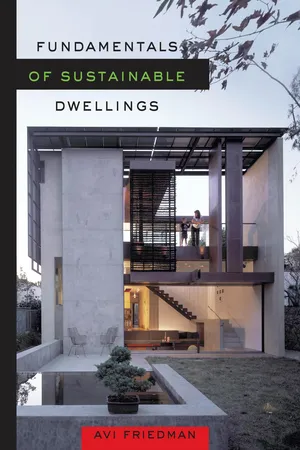
- 272 pages
- English
- ePUB (mobile friendly)
- Available on iOS & Android
eBook - ePub
Fundamentals of Sustainable Dwellings
About this book
Despite a prolonged slump in the housing market, the demand for residential green building remains strong. More than ever, professionals need reliable information about how to construct or retrofit livable, sustainable, and economical homes. With Fundamentals of Sustainable Dwellings, Avi Friedman provides that resource. While other books on residential green building are often either superficial or overly technical, Friedman gets it just right, delivering an illustrated, accessible guide for architects, developers, home builders, codes officials, and students of architecture and green design.
Friedman charts a new course for residential building—one in which social, cultural, economic, and environmental values are part of every design decision. The book begins with a concise overview of green building principles, covering topics such as sustainable resources and common certification methods. Each following chapter examines a critical aspect of green home construction, from siting to waste management options. Friedman provides basics about energy-efficient windows and heating and cooling systems. And he offers innovative solutions like edible landscaping and green roofs.
Friedman knows that in green building, ideas are only as good as their execution. So in each chapter valuable data is assembled and a contemporary project in which designers strove to achieve sustainability while adhering to real-world constraints is featured. The result is a practical guide for every professional in the burgeoning field of residential green building.
Friedman charts a new course for residential building—one in which social, cultural, economic, and environmental values are part of every design decision. The book begins with a concise overview of green building principles, covering topics such as sustainable resources and common certification methods. Each following chapter examines a critical aspect of green home construction, from siting to waste management options. Friedman provides basics about energy-efficient windows and heating and cooling systems. And he offers innovative solutions like edible landscaping and green roofs.
Friedman knows that in green building, ideas are only as good as their execution. So in each chapter valuable data is assembled and a contemporary project in which designers strove to achieve sustainability while adhering to real-world constraints is featured. The result is a practical guide for every professional in the burgeoning field of residential green building.
Frequently asked questions
Yes, you can cancel anytime from the Subscription tab in your account settings on the Perlego website. Your subscription will stay active until the end of your current billing period. Learn how to cancel your subscription.
At the moment all of our mobile-responsive ePub books are available to download via the app. Most of our PDFs are also available to download and we're working on making the final remaining ones downloadable now. Learn more here.
Perlego offers two plans: Essential and Complete
- Essential is ideal for learners and professionals who enjoy exploring a wide range of subjects. Access the Essential Library with 800,000+ trusted titles and best-sellers across business, personal growth, and the humanities. Includes unlimited reading time and Standard Read Aloud voice.
- Complete: Perfect for advanced learners and researchers needing full, unrestricted access. Unlock 1.4M+ books across hundreds of subjects, including academic and specialized titles. The Complete Plan also includes advanced features like Premium Read Aloud and Research Assistant.
We are an online textbook subscription service, where you can get access to an entire online library for less than the price of a single book per month. With over 1 million books across 1000+ topics, we’ve got you covered! Learn more here.
Look out for the read-aloud symbol on your next book to see if you can listen to it. The read-aloud tool reads text aloud for you, highlighting the text as it is being read. You can pause it, speed it up and slow it down. Learn more here.
Yes! You can use the Perlego app on both iOS or Android devices to read anytime, anywhere — even offline. Perfect for commutes or when you’re on the go.
Please note we cannot support devices running on iOS 13 and Android 7 or earlier. Learn more about using the app.
Please note we cannot support devices running on iOS 13 and Android 7 or earlier. Learn more about using the app.
Yes, you can access Fundamentals of Sustainable Dwellings by Avi Friedman in PDF and/or ePUB format, as well as other popular books in Architecture & Architecture General. We have over one million books available in our catalogue for you to explore.
Information
CHAPTER 1
Principles of Sustainable Dwellings
The limits of our environment, and how we have pushed those limits, are perhaps more apparent today than they ever have been. A growing awareness of the finite nature of energy and other resources has led more people to think of sustainability as a plus. The desire for environmental sustainability, along with today’s economic climate, has homeowners looking for alternatives to large, expensive, and expensive-to-maintain dwellings. Prior to introducing key components below, this chapter deals with overarching issues. Causes of global and local trends are discussed, sustainability principles illustrated, various resources categorized, and certification methods listed.
GLOBAL AND LOCAL TRENDS
New design practices have emerged in reaction to local and global trends. Understanding these trends is vital to the selection of appropriate strategies and solutions. Some of the most acute issues affecting the built residential environment, and principles to help in addressing them, are elaborated in the sections that follow.
Population Growth and Energy Consumption
In 2007, the Intergovernmental Panel on Climate Change (IPCC) published a report that addressed the role of humans in climate change. Among other things, they found that “global GHG emissions due to human activities have grown since pre-industrial times, with an increase of 70% between 1970 and 2004” (International Energy Agency 2008). The residential sector in the developed world is known to be the third-largest contributor to greenhouse gas (GHG) emissions, preceded by the industrial and transportation sectors. In 2005, for example, the residential sector of the Organization for Economic Cooperation and Development (OECD) countries contributed 21 percent of the total direct and indirect carbon dioxide emissions, totaling 23.1 gigatons (21 gigatonnes), as shown in figure 1.1 (International Energy Agency 2008).
Demand for energy is also growing rapidly. Between 1990 and 2005, consumption in OECD countries increased by 23 percent and electricity use by 54 percent (International Energy Agency 2008). In 2008, the residential sector of the United States consumed 21,635 trillion Btu (2.2826 × 1013 kJ), a staggering growth from the 14,930 trillion Btu (1.5751 × 1013 kJ) consumed in 1973 (US EIA 2009). Although efforts are being put forth to increase efficiency in energy creation, delivery, and use, it has become abundantly clear that further steps will have to be taken to encourage residential concepts that conserve natural resources and energy.
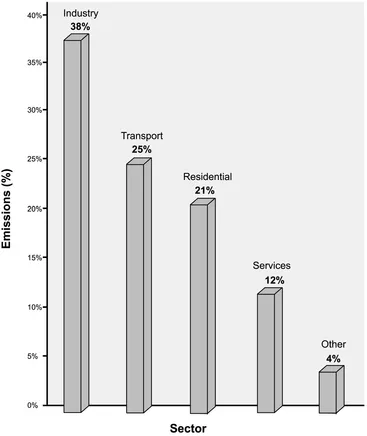
FIGURE 1.1 Carbon dioxide emissions by sector for OECD countries in 2005.
The global energy consumption increase can be attributed to several factors, including population growth and expanding home size. The US population grew by 30 percent to reach 300 million in 2005, up from 228 million in 1980 (US DOE 2009). The increase led to growth in the number of families and individuals seeking a shelter, which expanded the number of homes and, consequently, energy demand. In addition, the average household size shrank. There are simply more single-occupancy homes and apartments consuming energy. The number of households grew by 40 percent between 1980 and 2005, rising to 113 million from 80 million, which is significantly greater than the 30 percent population increase for the same period (US DOE 2009) (fig. 1.2). The average size of a North American home also grew along with the population and number of households. Increasing home size is regarded as the leading factor affecting the need for space heating, the largest energy consumer in the residential sector, as shown in figure 1.3.

FIGURE 1.2 Population and household increase in the United States illustrating greater growth in dwelling units than population over the same period.
Another rapidly growing energy consumer is household appliances. Because of their growing use, they are considered the second-largest household consumer, surpassing water heating. From 1990 to 2005 the energy consumption of appliances grew by 57 percent because of an increased number of large appliances per household and a variety of new smaller ones, as illustrated in figure 1.4 (International Energy Agency 2008). The use of Energy Star–certified appliances helped lower consumption, yet these savings were offset by the introduction of new gadgets such as high-energy-consuming LCD flat-screen TVs.
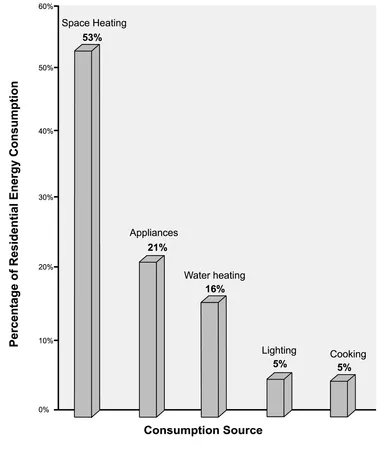
FIGURE 1.3 Residential energy consumption in the United States by source.
Wood-Frame Construction
Energy consumption is not the only environmental concern related to the development of homes and communities. Ubiquitous low-rise single-family wood-frame construction consumes a large amount of solid sawn lumber and therefore puts an increasing strain on forests and the environment. This dwelling type is addressed in this book since it constitutes some 65 percent of all residences built in North America. An acre (0.4 hectares) of forest is consumed to manufacture lumber for the construction of a single 1,700 sq ft (153 m2) dwelling (Nebraska Energy Office 2006). Since approximately 2 million new wood-frame homes are constructed annually, 2 million acres (0.8 million hectares) of deforestation takes place each year in the United States and Canada alone (US DOE 2009). Also, 27 million homes are retrofitted each year. While renovation consumes less lumber than building a new home, it still greatly contributes to extensive use of lumber. Additionally, the construction of a 2,000 sq ft (180 m2) house will produce 8,000 lb (3.6 tonnes) of waste during construction alone. Of this waste, 25 percent is solid sawn lumber while 15 percent is other manufactured wood products. Furthermore, if demolition is required for the very same house, the amount of waste increases to 127 tons (115 tonnes) per home (US DOE 2009; US EPA 1997).

FIGURE 1.4 Growth of residential equipment and appliances in the United States by type.
Auto-Centric Development
In 2005, the transportation sector contributed 26 percent of the total energy demand and 25 percent of the total direct and indirect carbon dioxide emissions of the OECD countries. A large portion of this consumption can be attributed to low-density development that requires extensive use of private cars. The US Census Bureau found that the average daily commute time to and from work in 2003 was 48.6 minutes (US Census Bureau 2009). Assuming that the vehicle is traveling at an average speed of 40 mph (64 kmh) and gets 20 mpg (8.45 km/L) of gasoline, the vehicle would travel 32.4 mi (52.1 km) daily, consuming 1.62 gallons (6.13 L) and emitting 31.69 lb (14.37 kg) of carbon dioxide per day. When a dwelling is sited within walking distance of amenities or when public transit is used, emissions are significantly reduced. In the Chicago metropolitan region, for example, households that live within a half mile of public transportation emit 43 percent less auto-related GHGs than those that reside farther away. Residents who live downtown, with the highest concentration of transit, jobs, housing, retail, and services, have 78 percent lower emissions. Furthermore, if sprawl continues to expand at the present rate, by 2030 its associated 60 percent rise of vehicle miles driven will completely negate progress made from efficient cars and low-carbon fuels (Hodges 2010).
In addition, a 2010 report by the US Department of Transportation has, upon rigorous examination of transit-related research, identified that public transportation can reduce GHGs in three principal ways: providing low-emission alternatives to driving; facilitating compact land use, which reduces the need for longer trips; and minimizing the carbon footprint of transit operations and construction (Hodges 2010).
PRINCIPLES OF SUSTAINABLE SYSTEMS
There are several perspectives on sustainability, each with its own importance to the environment, society, culture, and the economy. From an environmental perspective, for instance, every decision should be based on concerns for nature. In the private sector, meanwhile, decisions may be based on preventing the transfer of costs resulting from today’s bad decisions to future generations. The author’s perspective, however, is that the four fundamental aspects need to be given equal weight.
A sustainable built environment will result from overlapping these four issues, as shown in figure 1.5. The purpose of this book is to provoke and suggest new approaches to designing and building dwellings that are more sustainable and affordable.
The current, mainstream practices of dwelling design and construction need, in the author’s view, to be reconsidered. The three general principles that are shown in figure 1.6 can illustrate the process. When followed, they can guide the building of sustainable homes and communities.
The Path of Least Negative Impact
Development should follow the principle of the path of least negative impact. This principle argues for the least short- and long-term damage to the environment, society, and the economy.
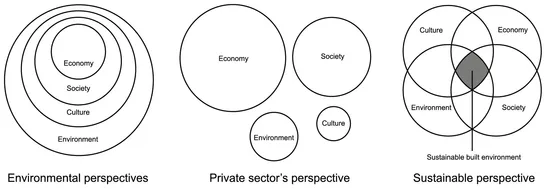
FIGURE 1.5 The various perspectives of sustainability. The built environment is the outcome of equal consideration of all four issues.
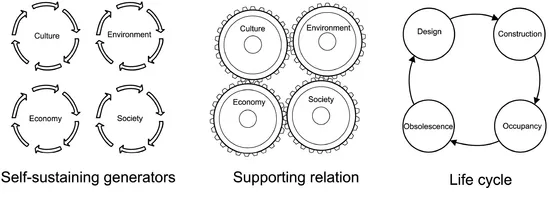
FIGURE 1.6 Principles of sustainable systems.
Self-Sustaining Process
Ideally a dwelling will be part of a self-sustaining process and will not need to draw extensively from external sources. Energy needs can, for instance, be supplied by photovoltaic panels, which can power appliances, and by solar collectors that can heat water. Additionally, if excess energy is produced, it can be used for communal needs and to power streetlights. Similarly, a self-sustaining water source can be obtained through the collection and purification of rainwater and the integration of a gray-water recycling system. This will help reduce the amount of energy used on public water purification.
Supporting Relationship
If one component of sustainability can positively affect another, then a supporting relationship will be formed. As more relationships emerge, a network will begin to develop. A dwelling that uses low-cost recycled materials, for example, not only helps the environment but becomes affordable to a wider range of consumers, leading to societal equity—a fundamental pillar of sustainability. Its “green” image may also turn out to be a marketing draw, as demonstrated in figure 1.7.
A Life-Cycle Approach
A dwelling is constantly evolving to accommodate the needs of its occupants. A dwelling that can be refurbished to extend its life is more sustainable than one that has a finite life. The home’s design concept, therefore, ought to include adaptability to emerging circumstances. If a home is well built, the owner will save on maintenance and operational expenses during occupancy. These savings can be invested in new eco-friendly technologies. Additionally, the home can be designed to be adaptable to the needs of various occupants and be...
Table of contents
- About Island Press
- Title Page
- Copyright Page
- Table of Contents
- PREFACE
- ACKNOWLEDGEMENTS
- CHAPTER 1 - Principles of Sustainable Dwellings
- CHAPTER 2 - Siting a Home
- CHAPTER 3 - Sustainable Residential Design Concepts
- CHAPTER 4 - Unit-Planning Principles
- CHAPTER 5 - Constructing a Home
- CHAPTER 6 - Building Materials
- CHAPTER 7 - Energy-Effi cient Windows
- CHAPTER 8 - Heating and Cooling Systems
- CHAPTER 9 - Healthy Indoor Environments
- CHAPTER 10 - Water Efficiency
- CHAPTER 11 - Green Roofs
- CHAPTER 12 - Edible Landscaping and Xeriscapi ng
- CHAPTER 13 - Waste Management and Disposal
- BIBLIOGRAPHY
- ILLUSTRATION CREDITS
- CASE STUDY PROJECTS TEAM
- CASE STUDY PROJECTS PHOTOGRAPHERS
- INDEX
- Island Press Board of Directors